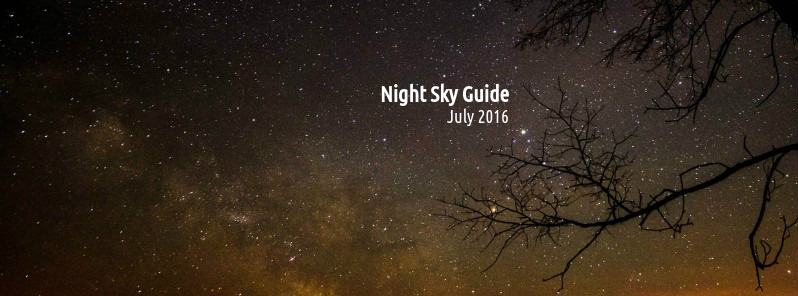Night sky guide for July 2016

July brings two meteor showers under relatively dark skies. Alpha Capricornids will reach their peak on July 26 with the maximum rate of around 5 per hour. A few days later, on July 29, the Delta Aquarid meteor shower will peak with up to 20 meteors per hour. The moon will present minimal interference for both of them.
The best time of the month to observe the night sky because there is no moonlight to interfere is on July 4. On the same day, Juno spacecraft will reach Jupiter after five years of traveling through space.
This month's full moon phase is on July 19.
-
July 4 – New Moon – 11:01 UTC. Moonless night, best the best time of the month to observe faint objects such as galaxies and star clusters.
-
July 4 – Juno reaches Jupiter. After five years of traveling through space, Juno spacecraft is expected to reach Jupiter. Coming face-to-face with the gas giant, Juno will begin to unravel some of the greatest mysteries surrounding our solar system's largest planet, including the origin of its massive magnetosphere. Juno will remain in orbit until October 2017, when the spacecraft will be de-orbited to crash into Jupiter.
-
July 16 – M55 well placed for observation. Globular cluster M55 (NGC 6809) in Sagittarius will be well placed for observation. At a declination of -30°58', it is easiest to see from the southern hemisphere and cannot be seen from latitudes much north of 39°N. It will reach its highest point in the sky at around midnight local time. At magnitude 7.0, M55 is quite faint, and certainly not visible to the naked eye, but can be viewed through a pair of binoculars or a small telescope.
-
July 16 – Conjunction between the Moon and Saturn – 05:43 UTC. The Moon and Saturn will make a close approach, passing within 3°24' of each other. At the moment of closest approach, the Moon will be at mag -12.4, and Saturn at mag -0.0, both in the constellation Ophiuchus. The pair will be too widely separated to fit within the field of view of a telescope, but will be visible to the naked eye or through a pair of binoculars.
-
July 19 – Full Moon – 22:58 UTC. At the exact moment when the Moon reaches full phase, it will lie at a declination of -17°03' in the constellation Sagittarius, and so will appear highest in the southern hemisphere. It will be visible from all latitudes north of 62°N. Its distance from the Earth will be 384 000 km (238 606 miles). This full moon was known by early Native American tribes as the Full Buck Moon because the male buck deer would begin to grow their new antlers at this time of year. Its other names are the Full Thunder Moon and the Full Hay Moon. Over the nights following July 19, the Moon will rise around an hour later each day, becoming prominent later in the night. Within a few days, it will only be visible in the pre-dawn and early-morning sky. By the time it reaches last quarter, a week after full moon, it will rise at around midnight and set at around noon.
-
July 20 – 81P/Wild at perihelion. Comet 81P/Wild will make its closest approach to the Sun, at a distance of 1.60 AU.
-
July 26 – Conjunction between the Moon and Uranus. The Moon and Uranus will make a close approach, passing within 2°47' of each other. At the moment of closest approach, the Moon will be at mag -12.1, and Uranus at mag 5.8, both in the constellation Pisces. The pair will be too widely separated to fit within the field of view of a telescope, but will be visible to the naked eye or through a pair of binoculars.
-
July 26 – Alpha Capricornid meteor shower. The maximum rate of activity of this minor meteor shower is on July 26, however, some shooting stars associated with the shower are expected to be visible each night from July to August. The maximum rate of meteors expected to be visible from a dark location is around 5 per hour (ZHR). The Moon will be 22 days old at the time of peak activity, and so will present minimal interference.
-
July 29 – Delta Aquarid meteor shower. This is a major meteor shower capable of producing up to 20 meteors per hour (ZHR) at its peak. The Moon will be 25 days old at the time of peak activity, less than 23% of it visible, and so will present minimal interference. The shower runs annually from July 12 to August 23. The pieces of space debris that interact with our atmosphere to create the Delta Aquariids are suspected to originate from comet 96P/Machholz. This short period comet orbits the Sun about once every five years. The Delta Aquariids are best viewed in the southern hemisphere and southern latitudes of the northern hemisphere.

Video courtesy Hubble Space Telescope
Sources: In The Sky (Dominic Ford), AMS
Featured image: Our Milky Way by Ryan Hallock (CC – Flickr)

Commenting rules and guidelines
We value the thoughts and opinions of our readers and welcome healthy discussions on our website. In order to maintain a respectful and positive community, we ask that all commenters follow these rules:
We reserve the right to remove any comments that violate these rules. By commenting on our website, you agree to abide by these guidelines. Thank you for helping to create a positive and welcoming environment for all.